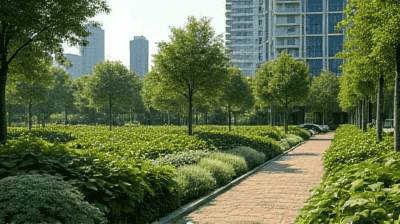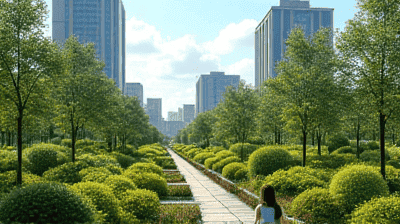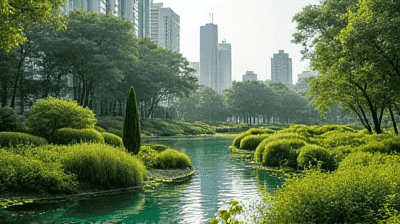How Urban Gardening Can Help Rehabilitate Polluted Land
In the face of rapid urbanization and industrial development, many cities around the world are grappling with the consequences of soil pollution. Contaminated land poses significant environmental and public health risks, affecting not only local ecosystems but also the communities that depend on these areas for food, recreational spaces, and overall quality of life. Urban gardening has emerged as an innovative solution to tackle these challenges by transforming polluted land into productive green spaces.
Understanding Soil Pollution in Urban Environments
What is Soil Pollution?
Soil pollution occurs when harmful chemicals, heavy metals, or other pollutants accumulate in the soil, degrading its quality and function. Urban areas are particularly susceptible to soil contamination due to activities such as:
Industrial Waste: Factories, power plants, and other industrial facilities often discharge harmful pollutants into the soil, including heavy metals, solvents, and hydrocarbons.
Agricultural Practices: The use of pesticides, herbicides, and synthetic fertilizers in urban agriculture can lead to chemical residues in the soil.
Waste Disposal: Improper disposal of household waste, as well as littering and illegal dumping, contributes to soil pollution.
Infrastructure Development: Construction activities can disturb contaminated soil, releasing pollutants into the environment.
The Impact of Soil Pollution
Soil pollution has far-reaching effects on both the environment and public health. Some significant impacts include:
Health Risks: Contaminated soil can lead to direct exposure through inhalation, skin contact, or ingestion, posing serious health risks such as respiratory issues, skin disorders, and organ damage.
Food Safety Concerns: Polluted soils can affect the safety of food crops, leading to the accumulation of harmful substances in plants and the food chain.
Biodiversity Loss: Soil contamination can disrupt ecosystems, leading to a decline in plant and animal species that are sensitive to pollutants.
Reduced Soil Productivity: Pollutants can diminish soil fertility, impairing its ability to support plant growth and agriculture.
The Role of Urban Gardening in Land Rehabilitation
Urban gardening refers to the practice of growing plants, flowers, vegetables, and fruits in urban settings. This practice not only enhances the aesthetic appeal of cities but can also play a crucial role in rehabilitating polluted land. The potential benefits of urban gardening for land rehabilitation include:
1. Phytoremediation
Phytoremediation is a process that uses plants to absorb, degrade, or stabilize contaminants in the soil. Urban gardens can leverage this technique through strategic plant selection. Some plants are known for their ability to uptake heavy metals and other pollutants, making them effective in cleaning contaminated soils. Examples of such plants include:
- Sunflowers: Known for their ability to absorb lead and other heavy metals from the soil.
- Mustard Greens: Effective at uptaking cadmium and other pollutants.
- Ragweed and Clover: These plants can help in stabilizing and remediating contaminated soils.
2. Soil Improvement
Incorporating compost and organic matter into urban gardening practices can significantly improve soil quality. Benefits include:
- Enhancing Soil Structure: Organic matter improves soil aeration, drainage, and nutrient retention, resulting in healthier soil.
- Microbial Activity: Compost introduces beneficial microorganisms that facilitate the breakdown of pollutants and enhance soil health.
- Nutrient Cycling: Decomposing organic matter releases nutrients that promote plant growth and improve ecosystem functions.
3. Community Engagement and Education
Urban gardening can serve as a platform for community engagement and education about environmental issues. Key aspects include:
- Fostering Awareness: Community gardens can raise awareness about soil pollution and its impacts, encouraging residents to take action.
- Workshops and Training: Teaching residents about sustainable gardening practices helps empower individuals to become stewards of their environment.
- Building Resilience: Engaging communities in gardening can enhance food security and resilience, particularly in urban areas with limited access to fresh produce.
4. Green Space Creation
Transforming polluted land into urban gardens can enhance local ecosystems by creating green spaces that provide various ecological benefits:
- Habitat Restoration: Urban gardens can provide habitats for pollinators and other wildlife, contributing to biodiversity in urban landscapes.
- Carbon Sequestration: Plants in urban gardens help sequester carbon dioxide from the atmosphere, mitigating climate change effects.
- Stormwater Management: Gardens can improve water retention and reduce runoff, decreasing the risk of flooding and erosion.
Best Practices for Implementing Urban Gardening on Polluted Land
To maximize the effectiveness of urban gardening in rehabilitating polluted land, several best practices should be considered:
1. Site Assessment
Before establishing an urban garden on contaminated land, it is essential to conduct thorough site assessments. This includes:
- Soil Testing: Testing soil for contaminants, such as heavy metals, pesticides, and other pollutants, helps identify specific challenges and informs remediation strategies.
- Evaluating Soil Quality: Assessing soil structure, pH levels, and nutrient content provides valuable insights into the state of the soil and necessary amendments.
2. Selecting Appropriate Plants
Choosing the right plant species is critical for successful urban gardening on polluted land. Considerations include:
- Pollutant Tolerance: Select plants known for their ability to tolerate and remediate specific contaminants present in the soil.
- Native Species: Incorporating native plants can enhance local biodiversity and improve resilience to urban conditions.
3. Incorporating Organic Amendments
Adding organic matter to the soil can enhance its quality and support plant growth. Practices to consider include:
- Composting: Creating compost from kitchen scraps, yard waste, and other organic materials enriches soil and improves its structure.
- Mulching: Applying organic mulches helps retain moisture, suppress weeds, and gradually enrich the soil as they decompose.
4. Monitoring and Maintenance
Regular monitoring and maintenance of the urban garden are essential for long-term success. Key practices include:
- Soil Testing: Periodically testing soil to assess changes in contaminant levels helps manage and respond to potential risks.
- Plant Health Assessment: Monitoring plant growth and health can inform necessary interventions, such as reinforcing soil amendments or selecting alternate species if contamination is severe.
Challenges and Considerations
While urban gardening offers numerous benefits for rehabilitating polluted land, several challenges must be addressed:
1. Contamination Risk
Even with careful selection of plants and soil amendments, there may be risks associated with growing food in contaminated soil. Considerations include:
- Bioaccumulation: Some plants can accumulate harmful substances in their tissues, potentially posing risks if consumed. It is essential to test crops for residual contaminants before harvest.
- Public Perception: Overcoming public skepticism regarding food safety in urban gardens on polluted land requires transparency and education.
2. Resource Limitations
Establishing and maintaining urban gardens may require resources that are not readily available, such as:
- Funding: Securing funds for soil testing, site preparation, and ongoing maintenance can be a barrier for community-led initiatives.
- Technical Expertise: Access to knowledge and technical expertise about soil remediation and urban gardening practices can vary among communities.
3. Environmental Conditions
Urban gardens often face environmental challenges, including soil compaction, limited sunlight, and water availability. Mitigation strategies include:
- Raised Beds: Constructing raised garden beds can improve soil health and drainage while minimizing soil compaction.
- Water Management: Implementing rainwater harvesting systems and using drought-resistant plants can help manage water resources effectively.
Case Studies of Successful Urban Gardening Projects
Several cities around the world have successfully implemented urban gardening initiatives aimed at rehabilitating polluted land. Here are a few noteworthy examples:
1. The Battye Street Community Garden (Australia)
Located in a former industrial site in Perth, the Battye Street Community Garden was established to rehabilitate contaminated soil while providing fresh produce for the local community.
- Implementation: The community garden utilized phytoremediation techniques, planting species capable of absorbing heavy metals, and incorporated extensive composting practices.
- Outcomes: The project successfully transformed the contaminated land into a vibrant community space that yields fresh vegetables, promotes education about soil health, and strengthens community ties.
2. The South Bronx Community Garden (United States)
In New York City, the South Bronx Community Garden was established on previously contaminated land to address food insecurity and soil pollution.
- Implementation: This project involved soil testing, raised bed construction, and the use of compost to improve soil quality. Community workshops focused on teaching sustainable gardening practices.
- Outcomes: The garden provides healthy food options for local residents, promotes community engagement, and serves as an educational platform for soil health awareness.
3. The Angell Street Community Gardens (Canada)
In Toronto, the Angell Street Community Gardens were created on contaminated land to rehabilitate the soil while providing green space for the community.
- Implementation: The project utilized organic farming practices, including community composting and the selection of native, pollutant-tolerant plants.
- Outcomes: The gardens contribute to urban biodiversity, engage local residents in sustainable practices, and improve overall environmental quality in the area.
Future Directions for Urban Gardening and Land Rehabilitation
As urban gardening continues to grow in popularity, there are specific future directions that can enhance its role in rehabilitating polluted land:
1. Policy Support
Government policies can play a critical role in promoting urban gardening initiatives. This includes:
- Zoning Laws: Updating zoning regulations to allow for community gardens on previously contaminated land can facilitate rehabilitation efforts.
- Funding Programs: Establishing grant programs to support urban gardening projects focused on pollution remediation can provide much-needed resources.
2. Research and Innovation
Investing in research focused on improving urban gardening techniques for soil rehabilitation is essential. Areas of research might include:
- Studying Plant-Soil Interactions: Understanding the relationships between different plant species and contaminated soils can improve remediation strategies.
- Innovative Technologies: Exploring technologies such as bioaugmentation and soil amendments enhances the benefits of urban gardening.
3. Expanding Community Engagement
Building strong community networks around urban gardening initiatives can enhance social cohesion and environmental advocacy. Strategies may include:
- Partnerships: Collaborating with local schools, non-profits, and environmental organizations can foster greater resources and support for urban gardening initiatives.
- Public Events: Engaging the community through open gardens, workshops, and farmers' markets can encourage participation and foster a sense of ownership.
Conclusion
Urban gardening offers a practical and sustainable approach to rehabilitating polluted land in cities worldwide. By leveraging the power of plants and community engagement, urban gardening can reduce soil pollution, enhance local ecosystems, and improve food security.
Through continuous innovation, robust policy support, and active community involvement, urban gardening can play a transformative role in creating healthier, greener, and more resilient urban environments. As cities continue to grapple with pollution challenges, the importance of urban gardening as a vital strategy for rehabilitation cannot be overstated.



